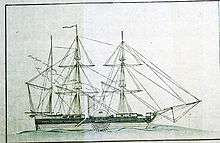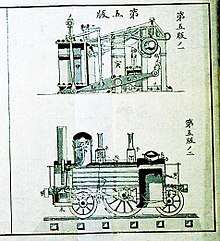Kawamoto Kōmin
Kawamoto Kōmin (川本 幸民, 1810 – June 1, 1871) was a 19th-century Japanese scholar of Rangaku and also a doctor. His true name was Yutaka (裕), art name Yuken (裕軒). His father was Kawamoto Shuan (川本 周安), a clan doctor of Sanda Domain.[1][2] Today he is known as a "father of chemistry in Japan" thanks to his works.[3][4]
He published various publications on science and technology such as Kagaku Shinsho (化学新書). Based on his specialized knowledge, he test-manufactured sugar[lower-alpha 1][5], match[6][7], and daguerreotype[6], which contributed to the development of technology in Japan. He is assumed to have brewed beer for the first time in Japan.[lower-alpha 2][1][5][3][6] He is also noted as the first person to have used the word Kagaku (化学) or chemistry, which is now widely used in Japan.[12]
Biography
Kawamoto Komin was born in Sanda Domain (now Sanda, Hyogo) in 1810.[1][13][6]
He started his education at the school of Sanda Domain at the age of 10 (in East Asian age reckoning). In 1827, he studied Kampo medicine at Konashi (木梨) Village (now Kato, Hyogo) for about a year.[13][6]
Two years later in 1829, having been attracted by Kawamoto's talent, Kuki Takakuni (九鬼隆国) ,the lord of Sanda Domain, had him study Western medicine in Edo (now Tokyo). Studying under Adachi Choshun (足立長雋) and Tsuboi Nobumichi (坪井信道) , he was quite at home in physics and chemistry.[13][6][11]
In 1833, he was appointed to a clan doctor as well as his father, and married Hideko (秀子), whose father was Aochi Rinso (青地林宗). In the next year, however, having committed a case of injury, he was forced to be under house arrest for six years. After the house arrest, he was caught in a fire twice. It was literally his dark days.[13][6]
In contrast, he had kept achieving great works in science and technology since late 1840s. According to his essay Yuken Zuihitsu (裕軒随筆), he test-manufactured white phosphorus match in 1848. He also issued many publications including translations, starting with Kikai Kanran Kogi (気海観瀾広義), which was published in 1851.[6] After being picked out by Shimazu Nariakira (島津斉彬) in 1854, the lord of Satsuma Domain, he came to belong to Satsuma Domain, and worked as a technical adviser.[13][6] In 1859, he became a professor at Bansho Shirabesho (蕃書調所), the predecessor of the present University of Tokyo.[13] In 1861, he published his famous Kagaku Shinsho (化学新書), which introduced modern chemistry in the West in those days. It is considered as one of the most important literatures on chemistry in Edo period, as well as Seimi Kaiso (舎密開宗) written by Udagawa Yōan. It was used as a textbook in Bansho Shirabesho.[12]
In 1868, he went back to his hometown Sanda and opened Eiran Juku (英蘭塾), a private school. The school soon became very popular and even a branch school was opened.[13][14] Later, his son Kiyojiro (清二郎) was appointed to Dajō-kan, and he went up to Tokyo again accompanying his son.[13][5] In June 1, 1871, he died in Tokyo at the age of 62.[1][13][5]
After his death
In 1953, a monument was built in front of Sanda Elementary School in Sanda City in honor of Kawamoto.[10][15]
In 2010, to commemorate the 200th anniversary of Kawamoto's birth, Konishi Brewing Company brewed beer with the manufacturing process in those days, referring to his translation, Kagaku Shinsho (化学新書), and the product has been on sale.[3][16]
Japan Academy possesses various related materials including Kagaku Shinsho, which were recognized as Chemical Heritage in Japan by Chemical Society of Japan in 2011.[17]
Major works


Kikai Kanran Kogi
Kikai Kanran Kogi (気海観瀾広義) was first published in 1851. The book consists of five volumes. Kawamoto improved Kikai Kanran (気海観瀾), the first book on physics in Japan, originally written by Aochi Rinso (青地林宗), who was his father-in-law.[6][18][19][20]
Ensei Kiki Jutsu
Ensei Kiki Jutsu (遠西奇器述) was published in 1854, a manual on many kinds of machinery and instruments such as steamship, daguerreotype, and telegraph.[21]
Kagaku Shinsho
Kagaku Shinsho (化学新書) was published in 1861. He translated the Dutch translation of "Die Schule der Chemie" written by Julius Adolph Stöckhardt, a German scientist.[5][12][22] In the book, he used the word Kagaku (化学) or chemistry for the first time instead of the word Seimi (舎密), which was more popular at the time.[lower-alpha 3][5][12]
Kagaku Shinsho consists of fifteen volumes and two sections: inorganic chemistry and organic chemistry. It was not printed, and its manuscripts were used as textbooks at Bansho Shirabesho, where Komin was working as a professor.[5][12] In Meiji Era he integrated it with other books on chemistry and published Kagaku Tsū (化学通).[17]
It is now considered to be one of the most prominent books on chemistry in late Edo period as well as Seimi Kaisō (舎密開宗) written by Udagawa Yōan. Compared to Seimi Kaisō the latest concepts at the time like atom, molecule, chemical compounds and chemical equation were explained in it.[5][12]
The inorganic chemistry section contains detailed specifics on chemical elements and chemical compounds. It covers various elements and compounds of acids (e.g. sulfuric acid, hydrochloric acid), light metals (e.g. sodium, potassium) and heavy metals (e.g.manganese, cobalt, lead). Komin assigned Kanji to each element as an element symbol e.g. "水", "炭", "窒" and "酸", which indicate hydrogen, carbon, nitrogen and oxygen for each. With this style of element symbol, for example, nitrogen dioxide (NO2) was expressed like this: "窒酸二", where "二" means two in Japanese. In the explanation of chemical compounds, the concept of formation of molecules with bonding was described with figures, in which John Dalton's atomic theory was first introduced to Japan.[5][12]。
In organic chemistry section, it was explained that plant component consists of four kinds of elements i.e. hydrogen, carbon, nitrogen and oxygen. The concept of isomers was explained with molecular formula. It also contains the latest knowledge at that time on organic chemistry e.g. protein, acetyl group, aldehyde and radical. In addition brewing of alcoholic drink was explained in detail. Komin is assumed to have brewed beer based on the knowledge gained through this.[5][8][9]
Notes
- He supervised test-manufacturing of sugar in Satsuma Domain, where he belonged at the time.[5]
- The legend says that he brewed beer and held a sampling party in Asakusa after Perry Expedition, while there is no existent record showing his brew.[5][8][6][9] Some literatures[1][10][11], however, refer to his success of brew of beer assertively.
- The word Kagaku was not a word of his coinage, but was borrowed from Chinese book. In fact Komin wrote a book named Banyū Kagaku (万有化学) in 1860, in which he adopted the word Kagaku for the first time. However Tokugawa shogunate prohibited the publication.[5][12]
References
- "川本幸民(かわもとこうみん)とはーコトバンク" (in Japanese). kotobank. Retrieved 2017-08-11.
- Kita 2008, p. 10
- Tsuji, Iwao (2011). "日本橋茅場町で造られた日本最初のビール" 幸民麦酒"" (PDF). Seibutsu-Kogaku Kaishi(生物工学会誌) (in Japanese). The Society for Biotechnology, Japan. 89 (2): 84–86.
- "初めてビールを醸造した日本人は「日本化学の祖・川本幸民」だったといわれる" (in Japanese). Kirin Company. Retrieved 2017-09-08.
- Shiba, Tetsuo (2003). "日本の化学を切り拓いた先駆者たち(2) : 川本幸民と化学新書(日本化学会創立125周年記念企画 8)". Chemistry & Education (in Japanese). Chemical Society of Japan. 51 (11): 707–710. doi:10.20665/kakyoshi.51.11_707.
- Okuno 1980, pp. 88–92
- Kita 2008, pp. 7, 140
- "川本幸民 酒・飲料の歴史 キリン歴史ミュージアム キリン" (in Japanese). Kirin Company. Retrieved 2017-08-11.
- Yamanouchi, Toshitaka (2004). "わが国ビール産業の揺籃期: 麦酒醸造技術の伝播と継承". 大阪産業大学経営論集 (in Japanese). Osaka Sangyo University. 6.1: 93–107.
- "三田市/川本幸民 顕彰碑" (in Japanese). Sanda City. Retrieved 2017-08-11.
- "Prominent People of Minato City (Komin Kawamoto)". Minato City. Retrieved 2017-08-11.
- Okuno 1980, pp. 130–133
- Sakanoue, Masanobu (1996). "兵庫県三田に生まれた川本幸民と化学新書(<特集>科学風土記 : 沖縄から北海道まで)". Chemistry & Education (in Japanese). Chemical Society of Japan. 44 (1): 14–15. doi:10.20665/kakyoshi.44.1_14.
- Kita 2008, p. 269
- Kita 2008, p. 163
- "幕末のビール復刻版 幸民麦酒 330ML" (in Japanese). Konishi Brewing Company. Retrieved 2017-08-10.
- Yatsumimi, Toshifumi. "化学遺産の第2回認定 認定化学遺産 第008号 日本学士院蔵 川本幸民 化学関係史料 抜群の語学の才に加え実験にも関心をもった川本幸民" (PDF) (in Japanese). Chemical Society of Japan. Retrieved 2017-08-11.
- Bartholomew, James R. (1989). The Formation of Science in Japan: Building a Research Tradition. Yale University Press. p. 34. ISBN 9780300042610.
- "気海観瀾(キカイカンラン)とは - コトバンク" (in Japanese). kotobank. Retrieved 2018-02-17.
- "気海観瀾広義(きかいかんらんこうぎ)とは - コトバンク" (in Japanese). kotobank. Retrieved 2018-02-17.
- Okuno 1980, p. 163
- Ohtaki, Hitoshi (2007). "Chemistry in Japan Lessons from the Past". Chemistry International. IUPAC. 29 (5). doi:10.1515/ci.2007.29.5.12.
Sources
- Okuno, Hisateru (1980). 江戸の化学 (玉川選書) (in Japanese). Tamagawa University Press. ISBN 978-4472152115.CS1 maint: ref=harv (link)
- Kita, Yasutoshi (2008). 蘭学者川本幸民 近代の扉を開いた万能科学者の生涯 (in Japanese). PHP Institute. ISBN 9784569699639.CS1 maint: ref=harv (link)
External links
- "Kikai Kanran Kogi (気海観瀾広義)" - NDL Digital Collections (in Japanese)
- Julius Adolph Stöckhardt (1855). Die Schule der Chemie. Friedrich Bieweg und Sohn. (in German)